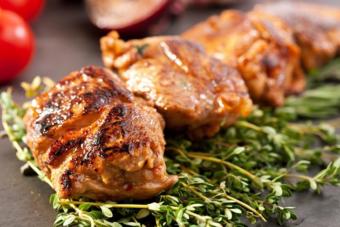Nowadays, there are various nutritional standards, and initially in Russia they were determined in 1930. Correctly speaking - physiological needs the human body in useful nutrients.
Coefficient physical activity(CFA) formed the basis in 1991 for calculating the nutritional norm.
The balance in the daily menu of an ordinary person should be between proteins, fats and carbohydrates, as follows:
- Proteins - 15%
- Fats - 35%
- Carbohydrates - 50%
If you play sports or drive active image life, then the ratio is:
- Proteins - 25-40%
- Fats - 10-20%
- Carbohydrates - 40-60%
The specific amount of food and calories - each person must calculate independently, taking into account age, gender, physical activity and activities throughout the day.
It is considered the average norm for women - 2000-2100 Kcal, and for men 2600-2800 calories per day.
Children during their growth period should receive sufficient amounts of proteins, fats, carbohydrates and nutrients such as vitamins, minerals, etc.
If you look into history, then earlier people consumed twice as many calories as today. This is due to the fact that they led an active and extreme lifestyle, constantly moved, hunted, in general - "survived as best they could." Of course, they spent a large amount of body energy to maintain their existence. Today, many people work in offices and do not spend much energy, in connection with this, food rations have been significantly reduced. Formerly men consumed about 5000 kcal per day, and now 2 times less, so compare how the diet has changed today.
If guys and girls go in for sports or lead an active lifestyle, then their need is more by 500-1500 Kcal, depending on the intensity and loads.
Ordinary people, if they eat a lot a day and violate the established norms, they will gain weight, and perhaps even become obese. Therefore, it is necessary to adhere to the optimal calorie menu for the day.
Important components of proper nutrition and nutrients

- Proteins are the main building element for muscles. This does not mean that only athletes and bodybuilders should use it. For the health of an ordinary person, you need 1 gram per 1 kilogram of weight per day, if your weight is 50 kg, respectively, 50 grams. squirrel. During growth, the child needs 2-5 times more protein(2-5 grams per 1 kg of weight), because the body is formed and grows. The amount of protein at a time is 20-30 grams, because more will not be absorbed at a time. Consider this moment when compiling your diet, if you play sports.
- Fats are a reserve or reserve source of energy for the body. There are healthy and unhealthy fats. Healthy fats have a positive effect on your health and should be added to your diet. The necessary ones are found in fatty tuna, herring, mackerel, salmon and others.
- Carbohydrates are the main source of energy. There are "fast" and "slow" carbohydrates. As you understand, preference should be given to "slow" carbohydrates, they are more useful. A large number of consumption of carbohydrates, turns into subcutaneous deposits if the body does not absorb them at a time. And the risk of deposition in subcutaneous fat refers to "fast" carbohydrates. “Slow” carbohydrates are starch, glycogen, cellulose, they are found in buckwheat, rice, hard pasta varieties and much more.
- Vitamins and minerals play an important role in human health. Be sure to eat foods rich in vitamins and nutrients daily. Vitamins affect the growth and development of people, mental and physical performance, are involved in regulating metabolism and protecting the body from diseases, etc.
Rational nutrition is understood as nutrition that is sufficient in quantity and complete in quality. basis rational nutrition is the balance (optimum ratio) of all food components. At least 60 substances that make up human food (essential and non-essential amino acids, polyunsaturated fatty acid, phosphatides, lecithin and sterols, including cholesterol, β-sitosterol, fats, sugars, starch and pectins, vitamins, mineral elements, organic acids, etc.). Modern nutritional hygiene studies not only the usefulness of vital substances exogenously entering the body, but also the issues of optimal synthesis of these substances in the body itself.
Rational nutrition is an important factor raising the level public health. Rational nutrition should take into account age, character labor activity, gender, climatic, national and individual characteristics. The monotony of food interferes with the balance of nutrition, inhibits the internal synthesis of substances. Shutdown for a long time individual groups food and sharp narrowing their range limit the body's ability to select vital substances, balance and maintain them normal level internal synthesis. The problem of the most complete use of the synergistic properties of nutrients, allowing to ensure the balance and usefulness of nutrition with its minimum energy value, is important task food hygiene.
The daily calorie requirement for people of active age in settlements with good or satisfactory public services has been developed (Table 1), as well as norms daily requirement in proteins and fats (table 2). The following principles of nutritional balance have been established and tested in practice: 1) the ratio of proteins, fats and carbohydrates - 1:1:4; 2) the amount of proteins (see Proteins in nutrition) - 14-15% daily calories; 3) the amount of proteins of animal origin - at least half of the daily norm of protein; 4) the amount of fat (see. Fats in nutrition) - 30% of daily calories; 5) specific gravity of animal fat - 75-80% and vegetable oil- 20-25% of the daily norm; 6) the amount of carbohydrates - 55-56% of the daily calorie content of the diet.
Table 1. Daily rate adult nutrition in calories
Note. Professional groups: I - professions not related to physical labor; II - professions of mechanized labor; III - professions of non-mechanized or partially mechanized labor; IV - professions of heavy, non-mechanized labor.
Table 2. Daily intake of proteins and fats 
Table 3. Daily nutritional allowances for children 
* The need for nutrients and anergy is given without taking into account the nutritional value of mother's milk.
Children need relatively more plastic substances. Taking into account this requirement, special physiological nutritional norms have been developed for children (Table 3).
Differentiation of the energy value of nutrition depending on climatic conditions produced by reducing fat intake in the southern zone and increasing it in the northern. The proportion of protein in all climatic zones remains constant. The rationing of carbohydrates is changing significantly, the share of which is increased in the diet of people living in the southern zone, and somewhat reduced in the northern regions.
Energy indicators of nutrition are not the same in different climatic zones. They are elevated in the northern zone and lower in the southern zone. The calorie content and the ratio of the main nutrients in different climatic zones for the male population engaged in mental labor and other activities not related to physical labor are shown in Table 4.
The nutrition of the elderly is built taking into account the characteristics of an aging organism: a decrease in the intensity of oxidative processes, a drop in cell activity, a slow flow metabolic processes, a decrease in the functionality of the digestive glands, etc., a reduction in the functions of all body systems and the development of atrophic processes. Hence the need to limit nutrition in old age. This limitation is made according to the volume physical activity and general level mobility in the elderly. For the elderly and old age the following physiological nutritional norms have been developed (Table 5).
Table 5. Daily dietary intake of the elderly

For people over 70 years of age, see Table 6 for energy and nutrient requirements.
In the diet of older people, there are fewer carbohydrates and partially fats (daily intake is not more than 80 g, including 70% of animals and 30% of vegetables). Refined foods are especially limited: sugar, confectionery, as well as bakery products premium, polished rice, semolina etc. The share of sugar should not exceed 15%, and the share of carbohydrates of potatoes, vegetables and fruits should not be less than 25% total carbohydrates daily ration. It is desirable to increase the share of whole grain products (bread from wholemeal flour, etc.). rational norm proteins in old age is considered 1 8 per 1 kg of body weight. In old age, the quality side of the proteins of the daily diet is important.
Of particular value are milk proteins - the most profitable sources essential amino acids(cm.). About 60% of the total amount of dietary protein should be provided by animal products, with half of this amount should be milk proteins.
Nutrition should be built taking into account the digestibility of food products. The coefficients of digestibility of basic foodstuffs are shown in table 7.
| Name of products | Digestibility ratio (in %) | ||
| proteins | fat | carbohydrates | |
| Meat and fish products | 95 | 90 | - |
| Milk, dairy products, eggs | 96 | 95 | 98 |
| Flour of the highest, I, II grades, bread from it, pasta, semolina, rice, hercules, oatmeal | 85 | 93 | 96 |
| Wholemeal flour and bread from it, legumes and cereals (except for semolina, rice, oatmeal and oatmeal) | 70 | 92 | 94 |
| Confectionery, honey, jam | 85 | 93 | 95 |
| Sugar | - | - | 99 |
| Fruits, berries, nuts | 85 | 95 | 90 |
| Vegetables | 80 | - | 85 |
| Potato | 70 | - | 95 |
In rational nutrition, importance is attached to vitamin usefulness. Vitamins (see) are vital in all age groups. The requirements for vitamins (mg / day) are shown in tables 8 and 9.


* For other vitamins, the requirements have not yet been clarified and are under development.
It is not always possible (for example, during the winter months) to satisfy the body's need for all vitamins due to their natural content in food products. Hence the need for fortification of the population arises. synthetic vitamins. In the USSR, flour, sugar, milk, and edible fats were fortified with vitamins (C, B1, B2, PP and A) (Table 10).

Vitaminization can also be carried out by directly introducing vitamins into food before consumption (in childcare facilities, hospitals, sanatoriums, factory and other public canteens). Priority fortification ascorbic acid children in child care facilities (35 mg/day per child) and patients in medical institutions(100 mg/day per patient). Important role play in food minerals(cm.).
Minerals are reasonably classified as biologically necessary substances. To ensure their digestibility, minerals must be balanced.
The physiological need of a person for some mineral elements is shown in table 11.

Importance has a power supply. For an adult, the most reasonable is a four-time meal with intervals between meals of 4-5 hours (table 12).

Note. I option - 3 meals a day; Option II - 4 meals a day.
For people of mental labor and the elderly, the diet can be more uniform without a sharp allocation of breakfast and lunch.
Human activity is associated with the expenditure of energy. Its amount is measured in calories. For normal life, it is necessary to constantly replenish the body with energy that enters it in the form of food.
The daily calorie intake depends on the gender, type of activity and age of the person. For example, men need more energy per day than women. And active young people who are still growing and developing spend more calories daily compared to adults.
Daily calorie intake for men
For active men
- under 30: 3,000 calories;
- from 30 to 50 years: within 2800 - 3000 calories;
- over 51: 2800 - 2400 calories.

For men with a sedentary lifestyle
- under 30: 2400 calories;
- 31 to 50 years old: 2200 calories;
- after 51 years, 2000 calories per day is enough.
For men with a moderate lifestyle
- 19-30 years old: 2600 - 2800 calories;
- 31-50 years old: 2400 - 2600 calories;
- from 51 years old: 2200 - 2400 calories.
daily calorie intake for women
For moderately active women
- up to 25 years, it is enough to consume 2200 calories per day for normal functioning their body;
- in 25-50 years, the recommended daily allowance is 2200 calories
- Over 51: Just 1,800 calories is enough.
With a sedentary lifestyle
- young girls under 25 years old will be enough for 2000 calories;
- women from 26 to 50 years old optimally consume no more than 1800 calories;
- after 51 years, you need to reduce your intake to 1600 calories.
With an active lifestyle
- young women 19 - 30 years old can consume 2400 calories;
- women in adulthood 31 - 60 years old need 2200 calories;
- women over 61 are recommended a daily allowance of 2,000 calories.
Individual calculation of the daily calorie intake
The above daily calorie intake values are generalized and approximate. But each person is individual and has his own height, weight, muscle mass and degree of activity. Therefore, scientists have derived formulas that allow you to calculate the daily calorie intake for different people.

Calories are calculated first necessary for a person in a state of complete inactivity and at a comfortable temperature. In other words, first of all, you need to find out how much energy the body needs to function. internal organs without physical and emotional stress. Usually this figure is laboratory conditions measured in lying position and in the absence of violent emotions. To measure it at home, formulas were derived for determining the value of basal metabolism (BMO).
Formulas for calculating BOO
- For men :
66 + (13.7 x weight in kg) + (5 x height in cm) - (6.8 x age in years)
- For women :
655 + (9.6 x weight in kg) + (1.8 x height in cm) - (4.7 x age in years)
For example:
For a 39-year-old woman weighing 70 kg and 168 cm tall, the BVR is calculated as follows:
655 + (9.6 * 70) + (1.8 * 168) - (4.7 * 39) = 1446.1 calories
Formula for Calculating Daily Calorie Need (DCA)
SPK = activity factor x BRO
Determining the activity factor value
- 1.2 - with a lifestyle without physical exertion;
- 1.375 - with light physical labor;
- 1.55 - with medium, moderate physical exertion;
- 1.75 - with heavy physical exertion;
- 1.9 - with especially hard physical labor.

For example:
With BOO = 1446.1 and with average activity (we take the coefficient - 1.55) daily allowance determined in the following way:
SPK \u003d 1446.1 * 1.55 \u003d 2241.46 calories
It is convenient to use a calorie calculator to calculate the daily allowance.
Daily calorie intake for weight loss
Knowing your SPC value, you can solve the problem with overweight. To do this, you just need to reduce the energy intake into the body with food. So you can create a calorie deficit, which will lead the body to the need to use up its reserves - fat.

To what extent is it safe to cut calories for weight loss? This is very important question, because with an incorrectly created energy deficit, the well-being and health of the losing weight will certainly suffer. For loss extra pounds it is necessary to reduce the value of the SEC by 500 - 1000 units. But at the same time, the minimum amount of daily calories consumed when losing weight for men is 1800, and for women - 1200. Below these values, it is very dangerous to create an energy deficit in the body.
Nutrition is the main source of filling the body necessary elements. The principles of healthy human nutrition involve daily consumption of a certain amount of proteins, fats, carbohydrates, trace elements and vitamins. We replenish all these components daily, taking food. Since food is the basis of the life of the body, Special attention it is worth paying attention to their quality, as well as the mode of eating.
Experts distinguish several types of nutrition - rational and dietary.
Fundamentals of rational human nutrition it is a healthy, balanced, daily food intake by a person, at a certain time with the maximum regulated amount of essential nutritional components.
correct diet food
- nutrition of a person with any deviations from normal operation organism. Such nutrition is compiled in such a way as to maximally support and “unload” a diseased organ or system of the human body.
Now let's take a closer look at the power components.
Squirrels- the main "building" element of the human body. Thanks to emu, new cells are formed, and it is also actively involved in metabolism. For normal life, a person needs to consume about 100-120 gr. protein per day.
Fats- the main source of energy in the human body. This element contains saturated and unsaturated fatty acids, lecithin, as well as vitamins A, B and E. Fats are also divided depending on their origin into animal and vegetable. A person needs to consume 100-150 grams per day. fats, keeping the balance that 70% of them should be of animal and 30% of plant origin.
Carbohydrates are also a source of energy for the human body. In combination with proteins, they contribute to the formation of hormones and enzymes necessary for the normal functioning of the body. On average, you need to consume about 400-500 grams per day. carbohydrates.
All this must be taken into account in order to understand human diet per day(on the nutrition of pregnant women a separate conversation). balanced diet and adherence to the diet, the human body regularly receives required amount nutrients needed for normal growth development and functioning of all organs and systems of the human body.
Proper nutrition is the key to your health and longevity. At the same time, to convince relatives and friends that counting the calorie content and the amount of food consumed is not such a simple matter. After all, for this you need to correct daily nutrition. A table will make this task easier. Daily human should include proteins, fats and carbohydrates. Today we will learn how to correctly calculate your rate, taking into account lifestyle and metabolic characteristics.
What are calories
This is basic concept that needs to be mastered. Calories are not harmful particles that settle on your thighs and stomach. This is the energy needed every day. The body receives it from food, and then spends it on maintaining the performance of all systems, as well as on daily work.
Energy is needed for everything. For mental work and breathing, for the heartbeat and any movements. That is, not only in order to pull weights in the gym. Each product has a special chemical composition. At the same time, the main substances are the same, just in different proportions. To be able to accurately determine the amount of consumed substances, you need a table. Daily human should be full and varied. You need to include as much as possible. useful products, and as little "ballast" as possible, that is, sweets and refined foods.

Why count them?
At first glance, it's boring - putting each piece on the scales, keeping records. But accuracy to the gram is not required at all. In addition, in a few days you will remember how much this or that portion of food weighs, and you can measure it by eye. And then we need a table. The daily diet of a person must include a variety of products so that as a result you get all the necessary substances, but at the same time do not go over the calories.
If you do not have a pre-written meal plan, then there is a very high chance of exceeding the daily intake of BJU. And usually the situation is as follows. Essential Substances, in particular, protein, is sorely lacking. And here fast carbohydrates obtained in excess. As a result, a person gains weight.
To avoid this, you need to make a clear nutrition plan for a month, a week and a day. After that, you need to calculate nutritional value, comparing with the table. The daily diet of a person should be compiled taking into account the division of calories into "harmful" and "useful".

Difference from diet
At first glance, absolutely none. Both here and there there is a restriction of the diet. But the principles are different in both cases. All diets have one big drawback - this is a limited set of products. As a result, the body suffers from a lack of certain nutrients. Even if you managed to endure a very strict diet and achieved good results, then he still did not give up his previous eating habits. As a result, they will spoil your harmony.
The daily diet of a person should be carefully measured, while the calculation of the energy value and the amount of food consumed should not become a temporary diet, but a new way of life. Then the result will be stable and long-term.

Your landmarks
If you decide to switch to proper nutrition, and start to understand what you eat, then you must definitely study energy value certain product groups. You don't have to learn them by heart. You can just refer to the table. The daily diet is calculated individually.
It all starts with the fact that you need to start a diary and break it into three columns. In the first, write down all the foods that were eaten and their energy value. The second is physical activity. And in the third, you need to fix changes in weight. By analyzing the data obtained for the week, month, year, you can adjust the diet and achieve the ideal result for you.
Each person needs a different amount of calories per day. This is due to his age and gender specifics, level of physical activity, metabolism. For example, if a woman does not move much, then it is enough for her to consume 2200 kcal per day. And a man, with a similar lifestyle, needs 2800 kcal.

If you want to lose weight
The only possibility is to reduce the calorie content of the diet. There is no other option. If you go to the gym and continue to eat above your norm, then muscles will grow under the layer of fat. Yes, and fat reserves often only increase, because a person calmly allows himself an extra bar, because he attends training, so he deserves it.
Therefore, it returns to our kcal table. With its help, the daily diet of a person can be calculated to the smallest piece. For weight loss, the calculations are as follows:
- If a woman does not play sports, then for weight loss it will be necessary to reduce the diet to 1000-1200 kcal per day. Men need about 600 kcal more of these numbers.
- For those involved in sports, large quantity energy. A woman is recommended 2000, and men 2700 calories per day.

Some subtleties
To reduce body weight, you need to learn how to control consumption high-calorie meals. The table will become a faithful assistant when calculating products for breakfast, lunch and dinner. But there are some other points to consider:
- The calorie content of water is not taken into account, since it is zero. This applies to water, tea and coffee. But if you add sugar, milk, honey, then they also need to take a place in your menu. More precisely, they should fit into the norm of consumed calories.
- If the menu includes complex, multi-component dishes, then to calculate the final figure, you will need to add the calorie content of all its components.
- When frying foods, you need to add the “weight” of oil to the calorie content of the product. It is recommended to use Teflon pans, which can only be lightly greased.
We calculate the individual norm
How many calories a day you are supposed to, you can calculate quite accurately. To do this, you need to multiply the value of your weight in kg by 24. This will be the calorie consumption rate for the body at rest. After that, it is disassembled as follows: 20% are fats, 40% are carbohydrates and 40% are proteins.
- 1.2 - for people who have a large excess weight and lead a completely inactive lifestyle;
- 1.4 - for people who go in for sports 2-3 times a week;
- 1.5 - if you are engaged in physical labor every day;
- 1.6 - for office workers.
Now let's look at a sample menu. The daily diet can and should be changed so that the dishes do not bother, but the principle remains the same. In this case, we will try to keep within the minimum 1200 kcal.
sample menu
The diet will not make you hungry. This can be seen only by looking at the proposed menu.
- For breakfast, prepare yourself 200 g vegetable salad(cabbage, lettuce, carrots, herbs), season them with a teaspoon of vegetable oil and add 50 g chicken meat.
- Snack - a glass of jelly.
- Lunch - 150 g each bean soup and vegetable roast with pork, 100 g potato biscuits.
- Snack - tea or kvass and a couple of breads.
- Dinner - 100 g of buckwheat and boiled chicken. Apple tea.
- Fat-free kefir before bed.
A fairly tolerable and varied daily diet should be compiled individually, preferably under the guidance of a nutritionist. If you feel weakness or deterioration, then you should immediately seek advice and reconsider the diet.





